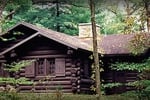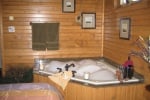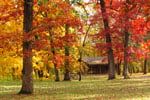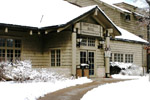LOWDEN STATE PARK
One of the most picturesque sites along the Rock River is just north of Oregon in Ogle County. Legend has it that Chief Black Hawk, as he left the area after the Black Hawk War, talked of the beauty of the area and admonished his captors to care for the land as he and his people had. Lowden State Park was established not only to care for the land but to allow visitors to share in the beauty as well. The park serves as a memorial to Gov. Frank O. Lowden, who served Illinois during World War I.
You can enjoy many wonderful views of the Rock River from the park, but the best view of the statue is from Illinois Route 2. Just north of Oregon, the bluffs are graced with a majestic image of an American Indian gazing over the Rock River Valley. This is no ordinary statue. It is a 50 foot, concrete-reinforced wonder that is awe-inspiring. A tribute to all Native Americans, but more commonly associated with Chief Black Hawk, the statue was designed by sculptor Lorado Taft. The setting sun seems to bring the statue to life, but it is a spectacular view any time of the day.
Chicago attorney Wallace Heckman, who was also assistant manager of the University of Chicago, purchased the land in 1898 that was to become Lowden State Park. He and his wife had developed a great love of the outdoors while college students. In Chicago society, the Heckmans also became patrons of the arts. They combined these two interests in an artists' colony they established on their Rock River property. The colony was called "Eagles' Nest," referring to a tall, dead cedar tree that clung to the high river bank. The bare outstretched limbs of the tree inspired Margaret Fuller, a poet of the Concord Group, to write the poem,"Ganymede to His Eagle."
For nearly 50 years, Eagles' Nest was a popular home for creative people. The original group included artists Ralph Clarkson, Charles Francis Browne and Oliver Dennet Grove; writers Hamlin Garland, Henry B. Fuller and Horace Spencer Fiske; architects Irving D. and Allen B. Pond; sculptors Lorado Taft and Nellie Walker; organist Clarence Dickinson; and University of Chicago Secretary James Spencer Dickerson. Although Taft was the moving spirit behind the colony, it continued to flourish until 1942, six years after his death.
About a year after the last of the artists and their families left the colony, Gov. Lowden died, and the legislature appropriated $25,000 toward the cost of a memorial to him. The citizens of Oregon and the vicinity, with help from the Department of Natural Resources, matched that amount so that the former Eagles' Nest land could be purchased as a memorial park. In 1945, the 63rd General Assembly designated the 273-acre site as Lowden State Park.
Six years later, the 66 acres that composed the actual Eagles Nest Colony were transferred to Northern Illinois University at DeKalb for use as a outdoor teacher education program. The site, called the Lorado Taft Field Campus, was renovated by NIU's Industrial Arts classes and is used year-round for conducting natural science classes in an outdoor setting.
Day-UseFishingyes
Huntingyes
Hiking Trailyes
Swimming Beachyes
BoatingLaunch Rampsyes
CampingPrimitiveyes
Electric Sitesyes
WinterActivitiesyes
Individual and group camping sites include limited electricity, a shower building, and a sanitary dumping station for trailers. During the summer, a refreshment stand provides cool drinks and snacks. Please contact park staff upon arrival for a camping permit.

Cottages and Cabins
Located within White Pines Forest State Park in Northwestern Illinois, hidden away in a place that seems like time forgot, discover the historic lodge restaurant, pioneer guest cabins, delightful country gift shop, and entertaining dinner theatre.
6.8 miles from park*

Cottages and Cabins
We would like to welcome you to the lodge and cabins at White Pines Inn. Located in Illinois White Pines State Park, there are 385 acres of peace and tranquility waiting for you here, with miles of hiking trails to explore the wonders of nature.
6 miles from park*








